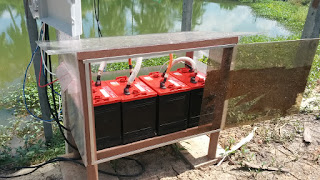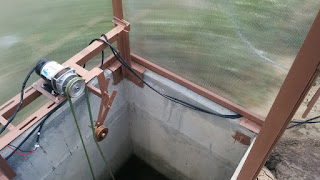We’ve connected up the solar panels to batteries and a charge controller now.
 |
| 2x 280W solar panels mounted near a pump shed |
You can see the pump shed behind the solar panels, the battery shed on the ground to the left, and the edge of the electrical box sticking out from the back left support pole.
Note how the solar panels are tilted about 10 degrees south (Bangkok being 13 degrees north of the equator).
Here are the batteries:
Each one is rated at 6V and 225Ah (for a 20hr discharge rate), and they weigh about 28kg (62 lbs) each. They are normally used for golf carts. There are 4 of them in series for 24v, 5.4kWh. You can see a piece of brown acrylic we had left over from tinted lighting windows in the house used as a sliding door. When it slides into place, the little battery cabinet is mostly rain proof. Nonetheless, it has air vents on 3 sides to let gas escape since lead acid batteries produce hydrogen gas when charging.
Here is a picture of the charge controller in the electrical box:
The charge controller is rated at 900W with a maximum load current of 30A. The last few days have been very sunny, so the batteries have been fully charged to about 26v. The lower right holds the pump motor controller circuit which we made ourselves with the help of pommm. It was taken out for servicing on Friday, though. It had a minor problem that caused a resistor to burn out in the first test, but this should be easy enough to fix. Hopefully we’ll be able to do a second test in the next few days.
The pumps have been wired up also:
You can see the black wire hanging loosely on the right side. I will wait for the initial experiments to prove successful before tidying up the wiring with nylon zip straps. The two motors are each driven by a separate circuit, so they can be turned on and off independently.
In theory, the circulation pump is more efficient at lower impeller speeds since we are not pumping the water to a higher elevation at all, so any resistance to be overcome is caused by friction, which will be substantially less at lower speeds. As a result, the pump controller is designed to be intelligent enough to monitor the charge state of the batteries and reduce the pump rate as the batteries draw down (i.e. over night). Ideally, the pumps will be on 24/7, just at a reduced rate dependent on the amount of sunshine that day.
The controller already has a voltage sensor for the battery and a current sensor for each pump. But in these first tests, I am using a constant PWM drive until any problems with the circuit gets finalized.



